 W
WA caltrop is an area denial weapon made up of two or more sharp nails or spines arranged in such a manner that one of them always points upward from a stable base. Historically, caltrops were part of defences that served to slow the advance of troops, especially horses, chariots, and war elephants, and were particularly effective against the soft feet of camels. In modern times, caltrops are effective when used against wheeled vehicles with pneumatic tires.
 W
WThe cheval de frise was an anti-cavalry measure consisting of a portable frame covered with many projecting long iron or wooden spikes or spears. They were principally intended as an anti-cavalry obstacle but could also be moved quickly to help block a breach in another barrier. They remained in occasional use until they were replaced by wire obstacles just after the American Civil War. During the Civil War, the Confederates used this type of barrier more often than the Union forces. During World War I, armies used chevaux de frise to temporarily plug gaps in barbed wire. Barbed wire chevaux de frise were used in jungle fighting on the South Pacific islands during World War II.
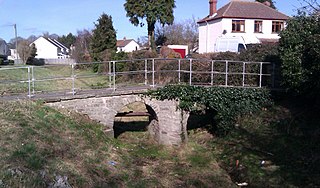 W
WThe Clawdd-du, also known in historical records as the Black Dyke, Black Ditch or Clawthy, is a mediaeval linear defensive earthwork or moat, constructed as protection for the faubourg of Overmonnow, on the opposite side of the River Monnow from the town and castle of Monmouth, Wales.
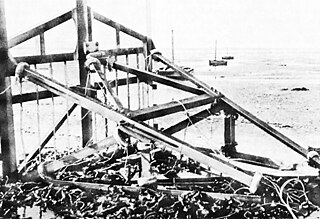 W
WThe Cointet-element, also known as a Belgian Gate or C-element, was a heavy steel fence about three metres wide and two metres high, typically mounted on concrete rollers, used as a mobile anti-tank obstacle during World War II. Each individual fence element weighed about 1,280 kg but was movable through the use of two fixed and one rotating roller. Its invention is attributed to a French colonel, Léon-Edmond de Cointet de Fillain, who came up with the idea in 1933 during the run-up to World War II, as to be used in the Maginot Line. Besides their use as barricades to the entrances of forts, bridges and roads, the heavy fences are best known for their use in the Belgian Iron Wall of the KW-line and their re-use as beach obstacles on the Atlantikwall.
 W
WConcertina wire or Dannert wire is a type of barbed wire or razor wire that is formed in large coils which can be expanded like a concertina. In conjunction with plain barbed wire and steel pickets, it is most often used to form military-style wire obstacles. It is also used in non-military settings, such as when used in prison barriers, detention camps, riot control, or at the U.S./Mexico Border.
 W
WA ditch in military engineering is an obstacle, designed to slow down or break up an attacking force, while a trench is intended to provide cover to the defenders. In military fortifications the side of a ditch farthest from the enemy and closest to the next line of defence is known as the scarp while the side of a ditch closest to the enemy is known as the counterscarp.
 W
WIn fortification, the term entrenchment can refer to either a secondary line of defence within a larger fortification, or an enceinte designed to provide cover for infantry, having a layout similar to a city wall but on a smaller scale. The latter usually consisted of curtain walls and bastions or redans, and was sometimes also protected by a ditch.
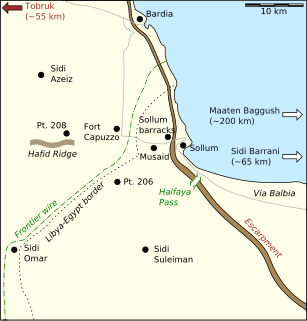 W
WThe Frontier Wire was a 271 km (168 mi) obstacle in Italian Libya, along the length of the border of British-held Egypt, running from El Ramleh, in the Gulf of Sollum south to Jaghbub parallel to the 25th meridian east, the Libya–Egypt and Libya–Sudan borders. The frontier wire and line of covering forts, were built by the Italians during the Second Italo-Senussi War (1923–1931), as a defensive system to contain the Senussi population, who crossed from Egypt during their resistance against the Italian colonisers. From the Italian declaration of war on 10 June 1940 to late 1942, it was the scene of military engagements between Italian, British and German forces as the fighting ebbed and flowed across the frontier.
 W
WLilia are pit traps arranged in a quincunx pattern dug by the Roman armies in front of their defences. Frequently they had sharpened stakes set inside them as an extra obstacle to attackers.
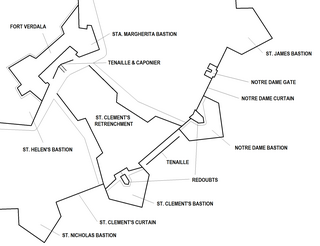 W
WRetrenchment is a technical term in fortification, where it is applied to a secondary work or series of works constructed in rear of existing defences to bar the further progress of the enemy who succeeds in breaching or storming these. An example was in the siege of Port Arthur in 1904.
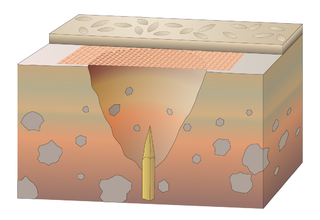 W
WIn medieval fortification, a trou de loup was a type of booby trap or defensive obstacle. Each trou de loup consisted of a conical pit about 2 m deep and 1.2 to 2 m wide at the top. At the bottom of the pit, a sharpened punji stick would be hammered in. In some cases, the pit was concealed by light cover of wicker and a layer of soil.
 W
WIn the military science of fortification, wire obstacles are defensive obstacles made from barbed wire, barbed tape or concertina wire. They are designed to disrupt, delay and generally slow down an attacking enemy. During the time that the attackers are slowed by the wire obstacle they are easy to target with machinegun and artillery fire. Depending on the requirements and available resources, wire obstacles may range from a simple barbed wire fence in front of a defensive position, to elaborate patterns of fences, concertinas, "dragon's teeth" and minefields hundreds of metres thick.